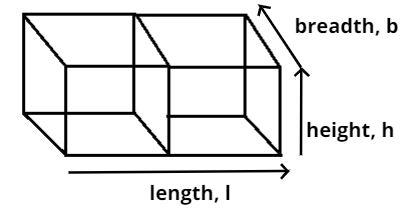
Two cubes each of volume $64c{m^2}$ are joined end to end. Find the surface area of the resulting cuboid.
Answer
501.3k+ views
Hint – In this question use the formula of volume of the cube which is ${(side)^3}$ to get the side of the cube. The length of the resulting cuboid is simply twice the side of the cube, the height is equal to the side of the cube and the breadth is also equal to the side of the cube.
Complete step-by-step answer:

Given data volume of each cube = 64 $cm^2$.
Now as we know that volume (V) of the cube is the side cube.
Let the side of the cube be a cm.
$ \Rightarrow V = 64 = {a^3}$
$ \Rightarrow a = \sqrt[3]{{64}} = 4$ cm.
So the side of the cube is 4 cm.
Now two cubes are joined together as shown in figure to make a cuboid.
So as we see that the length (l) of the cuboid is double the side of the cube but breadth (b) and height (h) of the cuboid remain the same.
Therefore l = 2a, b = a and h = a cm.
Therefore l = 8 cm, b = 4 cm and h = 4 cm.
Now as we know that the surface area (S.A) of the cuboid is $2\left( {lb + bh + hl} \right)$.
$ \Rightarrow S.A = 2\left( {lb + bh + hl} \right) cm^2$.
\[ \Rightarrow S.A = 2\left( {\left( {8 \times 4} \right) + \left( {4 \times 4} \right) + \left( {4 \times 8} \right)} \right) = 2\left( {32 + 16 + 32} \right) = 2\left( {80} \right) = 160 cm^2\].
So this is the required surface area of the resulting cuboid.
Note – Cube is a symmetrical three dimensional shape, either solid or hollow contained by six equal squares thus combination of two cubes leads to formation of a cuboid. A cuboid has 6 faces so to find the surface area of a cuboid, add the areas of all the 6 faces, that’s why the formula for surface area $S.A = 2\left( {lb + bh + hl} \right)$.
Complete step-by-step answer:

Given data volume of each cube = 64 $cm^2$.
Now as we know that volume (V) of the cube is the side cube.
Let the side of the cube be a cm.
$ \Rightarrow V = 64 = {a^3}$
$ \Rightarrow a = \sqrt[3]{{64}} = 4$ cm.
So the side of the cube is 4 cm.
Now two cubes are joined together as shown in figure to make a cuboid.
So as we see that the length (l) of the cuboid is double the side of the cube but breadth (b) and height (h) of the cuboid remain the same.
Therefore l = 2a, b = a and h = a cm.
Therefore l = 8 cm, b = 4 cm and h = 4 cm.
Now as we know that the surface area (S.A) of the cuboid is $2\left( {lb + bh + hl} \right)$.
$ \Rightarrow S.A = 2\left( {lb + bh + hl} \right) cm^2$.
\[ \Rightarrow S.A = 2\left( {\left( {8 \times 4} \right) + \left( {4 \times 4} \right) + \left( {4 \times 8} \right)} \right) = 2\left( {32 + 16 + 32} \right) = 2\left( {80} \right) = 160 cm^2\].
So this is the required surface area of the resulting cuboid.
Note – Cube is a symmetrical three dimensional shape, either solid or hollow contained by six equal squares thus combination of two cubes leads to formation of a cuboid. A cuboid has 6 faces so to find the surface area of a cuboid, add the areas of all the 6 faces, that’s why the formula for surface area $S.A = 2\left( {lb + bh + hl} \right)$.
Recently Updated Pages
Full Form of IASDMIPSIFSIRSPOLICE class 7 social science CBSE

In case of conflict between fundamental rights of citizens class 7 social science CBSE

Can anyone list 10 advantages and disadvantages of friction

What are the Components of Financial System?

Complete the letter given below written to your Principal class null english null

Express the following as a fraction and simplify a class 7 maths CBSE

Trending doubts
Who was Subhash Chandra Bose Why was he called Net class 10 english CBSE

Saptarishi is the Indian name of which Constellation class 10 social science CBSE

Complete the sentence with the most appropriate word class 10 english CBSE

Fill the blanks with proper collective nouns 1 A of class 10 english CBSE

List out three methods of soil conservation

Who is the executive head of the government APresident class 10 social science CBSE




